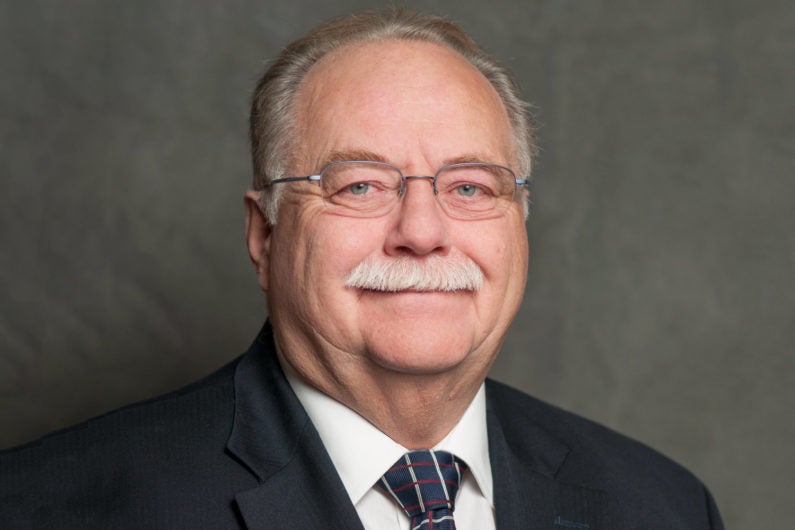EH&S Associate Vice Provost Larry Gibbs to retire in June
Gibbs, associate vice provost for environmental health and safety, has served Stanford for 26 years.
Lawrence Gibbs, associate vice provost for environmental health and safety, has announced plans to retire in June after more than two and a half decades on the job.

Lawrence Gibbs, Stanford’s associate vice provost for environmental health and safety, will retire in June. (Image credit: L.A. Cicero)
Gibbs, nationally recognized as a leader in the environmental health and safety issues facing modern universities, is perhaps best known for helping to transition laboratory safety on campus from an emphasis on enforcing rules to the creation of a strong culture of safety.
Through nearly 26 years, Gibbs said he has tried to maintain his focus on helping researchers do their work. “I think we have developed a best-in-class mission-support environmental health and safety program,” he said. “We’re here to help support the mission of the university.”
“What Larry has accomplished on behalf of Stanford is remarkable given the very broad spectrum of his responsibilities for keeping our community safe,” said Ann Arvin, vice provost and dean of research. ”He has a comprehensive knowledge of the best practices to mitigate environmental risks, whether the concerns are related to a specific area of research, such as chemistry, general university operations, such as fire safety, or emergency preparedness.”
She added, “Among his most important and lasting contributions, Larry has worked closely with faculty to implement an innovative approach to laboratory safety, with a focus on the education of researchers to create and maintain a culture of safety in the laboratories where they work.”
Steadying the ship
Gibbs had his work cut out for him when he started in October 1992. There had been five environmental health and safety directors in the prior six years, and the state environmental protection agency had accused university laboratories of mishandling hazardous waste – an allegation that ultimately resulted in nearly $1 million in fines. On his first day in the office, officials from the U.S. Department of Justice showed up to investigate allegations related to cleaning up after the 1989 Loma Prieta earthquake.
“I said, ‘What have I gotten myself into?’” Gibbs recalled.
Working with then-president Gerhard Casper and then-provost Condoleezza Rice, Gibbs resolved those issues and helped to change state regulations so they made more sense in the context of research laboratories, rather than the industrial settings for which they had been designed.
Then Gibbs set to work on a proactive plan for improving environmental health and safety at Stanford. One of the first major changes, he said, was hiring staff with strong technical backgrounds – a number of his staff over the years have come out of Stanford research labs, in fact – and supporting ongoing hands-on training.
Gibbs also undertook a decade-long effort to create the Occupational Health Center, housed in the Environmental Health and Safety building. Before the center’s opening in 2007, staff and researchers had to go to third-party providers in Palo Alto or Redwood City, making it harder to provide consistent care to injured workers. Throughout, Gibbs said, he has sought to partner with others around campus – public safety officials, risk management employees and even Stanford athletics – to improve health and safety.
A culture of safety
In 2013, following incidents at two other nationally known universities, Gibbs helped form a task force aimed at advancing laboratory safety. It was the first time a university had taken such a careful look at its own practices, Gibbs said, and has inspired similar efforts around the country.
“That really led to a seminal review of safety culture in labs,” Gibbs said. “It was a little bit ahead of its time.”
The report made 22 recommendations and a number of eye-opening findings, among them a divide in the perceptions of safety as a priority in Stanford labs. While nearly all principal investigators viewed safety as a top concern in their laboratories, nearly 30 percent of the researchers working day to day in those labs felt that safety was not prioritized.
Gibbs’ efforts to improve the lab culture of safety extend off the main campus as well. Starting in 2008, he worked closely with Provost Persis Drell, who at the time was the director of SLAC National Accelerator Laboratory, to improve lab safety at the facility.
“In my early days as director of SLAC, we had some tremendous safety issues at the lab,” Drell said. “Larry was thoughtful and supportive in helping us address these. He was willing to engage with us when we were underperforming and help us improve. I have always enjoyed the partnership with him.”
What’s next
Gibbs said that although he is retiring soon, he will remain active in environmental health and safety and plans to continue speaking and consulting on issues in the field. He also plans to remain active in the wider Stanford community – he has been an auxiliary member of the Stanford Athletics Board since 2009, for example. “If there’s one thing I can encourage people to do, it’s to get involved in activities at Stanford,” he said.
But stepping down from his position will give him more time for golf and for time with his grandchildren – he has one in Dublin, California, and three in North Carolina whom he plans to visit more often.
Over 26 years, Gibbs said he has seen a lot of change. Notably, the pace of campus and emerging research activities related to environmental safety has increased and looks like it will keep increasing.
And there’s one other thing that stands out: “Twenty-six years ago, on Campus Drive from Junipero Serra to Junipero Serra, I think there were about six stop signs, and now there are 24. That has to be representative of something.”

